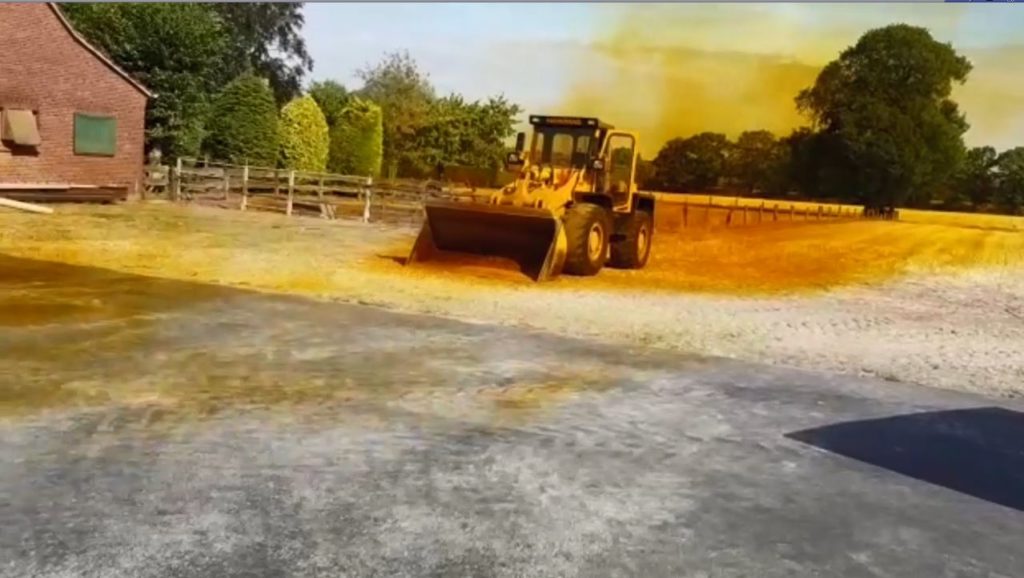Various gases can be produced during the harvesting, filling, and the first 2 to 3 weeks of ensiling periods. Silage gases can accumulate in tower silos, feed rooms, or livestock housing areas and can be fatal to both humans and animals.
Keep Out of Silage
- Stay clear of tower silos and silage piles for 2 to 3 weeks after filling.
- Ventilate feed rooms with open windows and fans during the danger period.
- Keep the doors between the tower silo feed room and livestock housing area closed tightly.
- If it is necessary to enter a tower silo after filling, do so as soon as the last load is off the truck or wagon. Do not wait until the next day and have the forage blower running while you are in the tower silo.
- If you must enter or open a tower silo within 3 weeks after filling:
- Ventilate the tower silo by running the forage blower for 15 to 20 minutes before entering with the door closest to the top of the tower silo open.
- Wear an approved, self-contained breathing apparatus and have a connection to a person outside the tower silo.
- When opening up a bag, pile, or bunker, allow any gases to fully dissipate overnight before allowing the feed team to begin removing silage.
Watch for Orange or Brown Gas
- Nitrogen dioxide (NO2) is heavier than air and characterized by an orange to a yellowish-brown color and a smell similar to laundry bleach.
- The highest levels of NO2 are usually present during the first 24 to 72 hours after the forage is put into the tower silo, but dangerous levels can persist for up to 3 weeks.
- NO2 gasses are usually associated with conventional, top-unloading tower silos. Leveling, sealing and unloader set-up operations in the confined headspace of these tower silos place entrants in peril during the 3-week danger period.
- NO2 gasses are still a risk for other ensiling structures such as bunkers, bags, or piles. Never approach silage emitting an orange to yellowish-brown gas: allow the gas to dissipate entirely.
- Depending on the NO2 concentration, the presence of this gas might be recognized by a burning sensation in the nose, throat, and/or chest. Exposure to high concentrations of NO2 can cause respiratory issues or death quickly without allowing time to detect respiratory symptoms.
- Move into the fresh air at once if you should experience even slight throat irritation or cough around a silage structure. See your doctor immediately if you suspect that you have been exposed to NO2.
- To help ensure safety, allow any orange to yellowish-brown gasses to fully dissipate before approaching the silage.
Figure 1: The Dangers of Nitrogen Dioxide Gas in a Tower Silo

Do Not Open Silage in Enclosed Environments
- Carbon dioxide (CO2) is an odorless, colorless, and tasteless gas that is heavier than air. It is particularly hazardous in sealed tower silos, where CO2 replaces oxygen in the confined headspace. In bunkers, bags, or piles, CO2 is often seen as a shimmering wave rolling down the silage and across the ground.
- The contained atmosphere in a tower silo can be almost entirely CO2, and survival in such an environment is entirely dependent on a safe external air supply.
- In conventional, top-unloading tower silos, CO2 can accumulate to dangerous concentrations by draining into low points on the silage surface.
- Take care when opening new season silages, especially in enclosed environments.
Additional reading
Check out these resources written by experts for more information on silage safety.
- Basics of Silage Safety Video. This 8-minute video is intended to make producers aware of the ever-present dangers when working around silage storage structures, and re-enforce good practices to reduce risks on their operations.
Silage Safety Handbook is a free download available in both English and Spanish. The handbook offers practical tips for building, maintaining, and feeding out silage bunkers and piles, plus information about the potential dangers of gases formed naturally during the ensiling process. Printed copies are available upon request.



